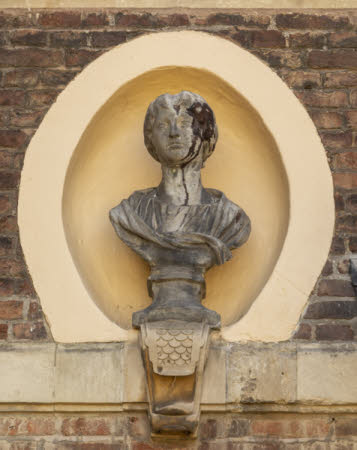Bust of the Roman empress Faustina the Younger
workshop of John Besnier (fl.1681)
Category
Art / Sculpture
Date
c. 1670 - 1672
Materials
Lead, Sandstone
Place of origin
London
Order this imageCollection
Ham House, Surrey
NT 1140351
Summary
A lead portrait bust of Faustina the Younger, daughter of the Roman emperor Antoninus Pius and wife of the Emperor Marcus Aurelius (c. 130-175/76 A.D.). She wears a dress over which is a cloak. One of thirty-eight lead busts made for the garden walls of Ham House in 1671-72, perhaps in the workshop of John Besnier, thirty-six of which survive in niches on the walls and on the north façade of the house.
Full description
A lead portrait bust of the Roman empress Anna Galeria Faustina the Younger (c. 130-175/76 A.D.), wearing a dress, over which is a cloak. Her hair is parted at the middle and carefully arranged in waves on each side of the head. Her head is tilted slightly to the right and she looks to her right. Mounted on a plinth, and placed on a sandstone console carved with a shield with scale decoration from which hangs a pendant and, below, a curling tongue and scroll. The distinctive hairstyle of the woman, with wavy hair parted in the middle and drawn back into a coil or bun, is a type seen in female portraiture from the Antonine period (138-192 A.D.). The portrait is in fact very close to a marble bust in the Gallerie degli Uffizi in Florence, which is identified on the socle as a portrait of Faustina the Younger, the daughter of the emperor Antoninus Pius and his wife Faustina the Elder (Guido Mansulli, Galleria degli Uffizi. Le Sculture, Vol. 2, Rome 1961, no. 124). At first betrothed to Lucius Verus (for his bust at Ham House, see NT 1139665), Faustina was in 145 married to her maternal cousin Marcus Aurelius, the adopted son of Faustina’s father Antoninus Pius. As empress from 161, Faustina accompanied her husband on many of his military campaigns and, living much of her life amidst in encampments, became very popular with the Roman army. Marcus Aurelius named her ‘Mother of the Camp’ (Mater Castrorum). He greatly grieved on her death and had Faustina deified. She may therefore be intended to represent an empress such as Faustina the Younger (c. 130 AD-175/76). One of thirty-six lead busts displayed in oval niches in the garden walls and on the north façade of Ham House, probably installed in 1671-72, and recorded in the 1679 inventory of Ham House. The entire series was probably arranged in its present positions along the garden walls and on the north front of Ham House by the 6th Earl of Dysart as part of improvements undertaken between 1798 and 1803. Although the majority of the busts are portraits of male subjects, these are complemented by a series of female busts, almost all of which are displayed on the north front of Ham House. Whilst a few depict Roman Empresses, as in the case of this bust, the features in most cases are not distinctive enough to allow identification. The long series of lead busts may well, like other sculpture at Ham House, have been made in the workshops of the Besnier family, perhaps by John Besnier, who received a commission for lead statuary from the Duke of Ormonde in 1681. They were originally painted so that they would appear, at least from a distance, to be made of marble. For a fuller discussion of the lead busts and their history and attribution, see NT 1140333. Jeremy Warren January 2022
Provenance
Probably made installed in 1671-72 to the commission of John Maitland and Elizabeth Murray, 1st Duke and Duchess of Lauderdale. Thence by descent,until acquired in 1948 by HM Government when Sir Lyonel, 4th Bt (1854 – 1952) and Sir Cecil Tollemache, 5th Bt (1886 – 1969) presented Ham House to the National Trust. Entrusted to the care of the Victoria & Albert Museum until 1990, when returned to the care of the National Trust, to which ownership was transferred in 2002.
Makers and roles
workshop of John Besnier (fl.1681), sculptor
References
Avery 2013: Charles Avery, ‘Seventeenth-century Sculpture at Ham House’ in Christopher Rowell, ed., Ham House. 400 Years of History, New Haven/London 2013, pp. 158-77., pp. 172-76

